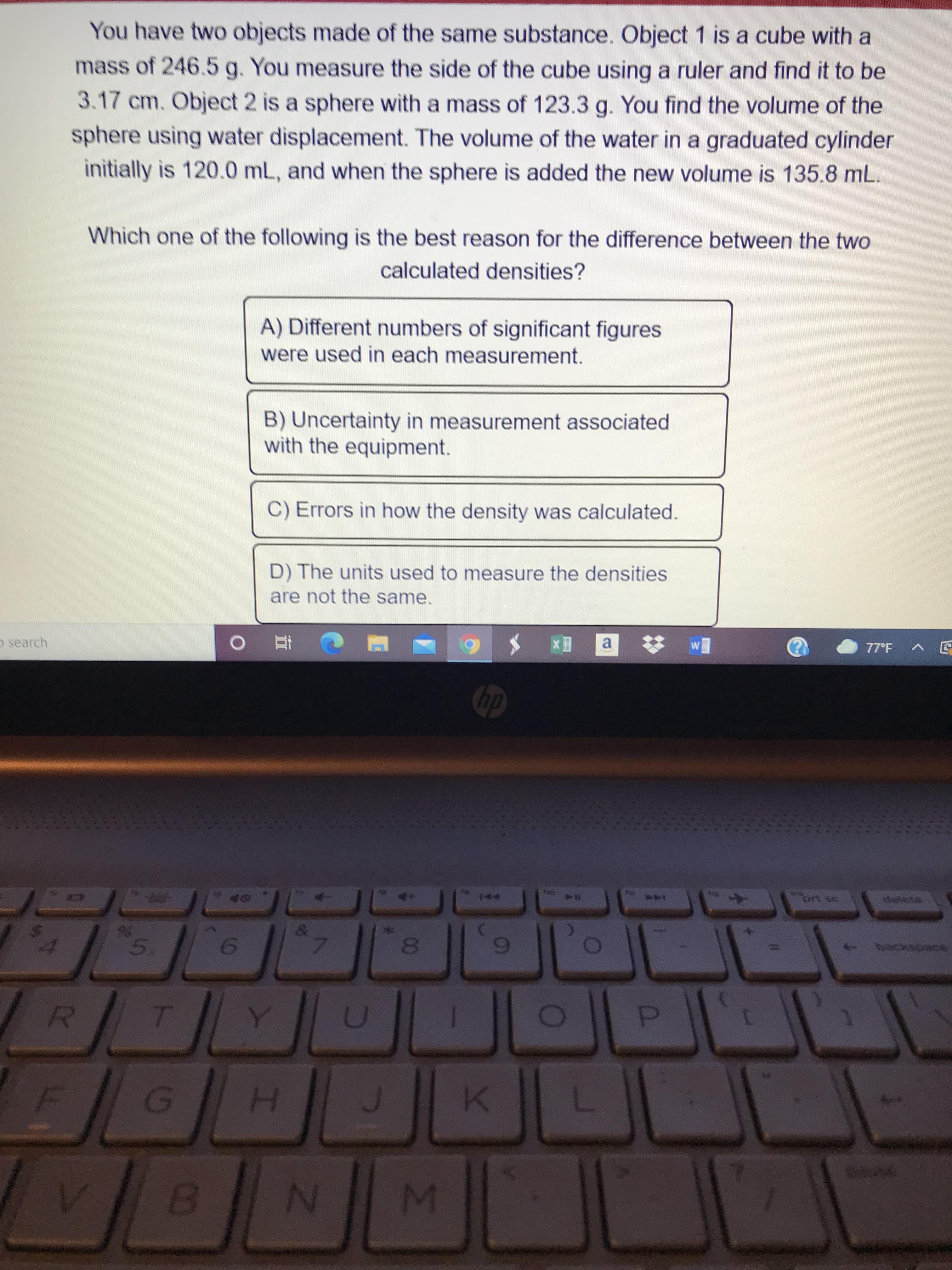You have two objects made mass of 246.5 g. You measur 3.17 cm. Object 2 is a sphere sphere using water displacem initially is 120.0 mL, and whe Which one of the following is
You have two objects made mass of 246.5 g. You measur 3.17 cm. Object 2 is a sphere sphere using water displacem initially is 120.0 mL, and whe Which one of the following is
Chemistry & Chemical Reactivity
9th Edition
ISBN:9781133949640
Author:John C. Kotz, Paul M. Treichel, John Townsend, David Treichel
Publisher:John C. Kotz, Paul M. Treichel, John Townsend, David Treichel
ChapterL: Let's Review
SectionL.2: Making Measurements: Precision, Accuracy, Experimental Error, And Standard Deviation
Problem 2RC: Two students were assigned to determine the mass of a sample of an unknown liquid. Student A used an...
Related questions
Question

Transcribed Image Text:00
G.
You have two objects made of the same substance. Object 1 is a cube with a
mass of 246.5 g. You measure the side of the cube using a ruler and find it to be
3.17 cm. Object 2 is a sphere with a mass of 123.3 g. You find the volume of the
sphere using water displacement. The volume of the water in a graduated cylinder
initially is 120.0 mL, and when the sphere is added the new volume is 135.8 mL.
Which one of the following is the best reason for the difference between the two
calculated densities?
A) Different numbers of significant figures
were used in each measurement.
B) Uncertainty in measurement associated
with the equipment.
C) Errors in how the density was calculated.
D) The units used to measure the densities
are not the same.
o search
a
77°F
delete
114
144
5.
6.
D.
Expert Solution
This question has been solved!
Explore an expertly crafted, step-by-step solution for a thorough understanding of key concepts.
This is a popular solution!
Trending now
This is a popular solution!
Step by step
Solved in 2 steps

Recommended textbooks for you

Chemistry & Chemical Reactivity
Chemistry
ISBN:
9781133949640
Author:
John C. Kotz, Paul M. Treichel, John Townsend, David Treichel
Publisher:
Cengage Learning

Chemistry: Principles and Reactions
Chemistry
ISBN:
9781305079373
Author:
William L. Masterton, Cecile N. Hurley
Publisher:
Cengage Learning

Chemistry: Matter and Change
Chemistry
ISBN:
9780078746376
Author:
Dinah Zike, Laurel Dingrando, Nicholas Hainen, Cheryl Wistrom
Publisher:
Glencoe/McGraw-Hill School Pub Co

Chemistry & Chemical Reactivity
Chemistry
ISBN:
9781133949640
Author:
John C. Kotz, Paul M. Treichel, John Townsend, David Treichel
Publisher:
Cengage Learning

Chemistry: Principles and Reactions
Chemistry
ISBN:
9781305079373
Author:
William L. Masterton, Cecile N. Hurley
Publisher:
Cengage Learning

Chemistry: Matter and Change
Chemistry
ISBN:
9780078746376
Author:
Dinah Zike, Laurel Dingrando, Nicholas Hainen, Cheryl Wistrom
Publisher:
Glencoe/McGraw-Hill School Pub Co

General Chemistry - Standalone book (MindTap Cour…
Chemistry
ISBN:
9781305580343
Author:
Steven D. Gammon, Ebbing, Darrell Ebbing, Steven D., Darrell; Gammon, Darrell Ebbing; Steven D. Gammon, Darrell D.; Gammon, Ebbing; Steven D. Gammon; Darrell
Publisher:
Cengage Learning

Chemistry: The Molecular Science
Chemistry
ISBN:
9781285199047
Author:
John W. Moore, Conrad L. Stanitski
Publisher:
Cengage Learning

Introductory Chemistry: A Foundation
Chemistry
ISBN:
9781337399425
Author:
Steven S. Zumdahl, Donald J. DeCoste
Publisher:
Cengage Learning